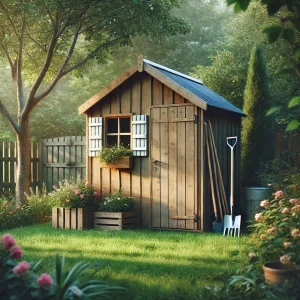
In the UK, there are several types of sheds available, each serving different purposes based on materials, design, and intended use:
Sheds come in various types and styles, each suited to different needs and preferences. Here’s an overview of the most common types of sheds and their typical uses:
1. Garden Sheds
- Purpose: Primarily used for storing gardening tools, equipment, and supplies.
- Features: Often equipped with shelving, workbenches, and ample storage space for pots, soil, and hand tools.
- Materials: Commonly made from wood, metal, or plastic.
2. Tool Sheds
- Purpose: Designed to store tools and equipment.
- Features: Includes features like pegboards for hanging tools, storage cabinets, and workbenches.
- Materials: Typically constructed from wood, metal, or durable plastic.
3. Storage Sheds
- Purpose: Used for general storage needs, such as seasonal items, outdoor furniture, or sports equipment.
- Features: Generally spacious with options for shelves or cabinets to organise items.
- Materials: Wood, metal, or resin are common materials.
4. Wooden Sheds
- Purpose: Versatile and aesthetic, used for various purposes from storage to workshops.
- Features: Can be customised with insulation, electrical wiring, and interior fittings.
- Materials: Constructed from treated timber, plywood, or cedar.
5. Metal Sheds
- Purpose: Ideal for secure storage and durability.
- Features: Often feature reinforced doors and robust construction to withstand harsh weather conditions.
- Materials: Usually made from galvanised steel or aluminium.
6. Plastic or Resin Sheds
- Purpose: Low maintenance and resistant to rot, rust, and pests.
- Features: Lightweight, weather-resistant, and often come with built-in ventilation.
- Materials: Made from high-density polyethylene (HDPE) or polypropylene.
7. Workshop Sheds
- Purpose: Designed for DIY projects, hobbies, or small-scale woodworking.
- Features: Includes workbenches, electrical outlets, and often heating or cooling systems.
- Materials: Typically made from wood, but metal and plastic options are also available.
8. Greenhouses
- Purpose: Used for growing plants and vegetables in a controlled environment.
- Features: Designed with transparent materials to allow sunlight in, often equipped with ventilation and heating systems.
- Materials: Constructed from glass, polycarbonate, or polyethylene sheeting.
9. Bike Sheds
- Purpose: Specifically designed to store bicycles securely.
- Features: Often includes secure locking mechanisms and space-efficient design.
- Materials: Made from wood, metal, or durable plastic.
10. Garden Offices or Studios
- Purpose: Serve as functional workspaces or creative studios separate from the main home.
- Features: Equipped with insulation, electrical wiring, and often features like windows for natural light.
- Materials: Typically constructed from wood or prefabricated panels.
11. Playhouses
- Purpose: Designed as play spaces for children.
- Features: Often include fun features like windows, doors, and sometimes even furniture or play equipment.
- Materials: Usually made from wood or plastic.
12. Potting Sheds
- Purpose: Specialised for potting plants and seed propagation.
- Features: Includes potting benches, storage for soil and pots, and often features good ventilation and natural light.
- Materials: Commonly constructed from wood or metal.
13. Lean-To Sheds
- Purpose: Attached to the side of a building or structure, providing additional storage.
- Features: Space-efficient, can serve as storage for tools or equipment.
- Materials: Typically made from wood or metal, matching the adjacent structure.
14. Chicken Coops
- Purpose: Provides housing for chickens.
- Features: Includes nesting boxes, roosting bars, and often an enclosed run area.
- Materials: Commonly constructed from wood or metal.
15. She Sheds and Man Caves
- Purpose: Personal retreats or hobby spaces for relaxation and leisure.
- Features: Customisable interiors with amenities like seating, entertainment systems, or personal collections.
- Materials: Can be made from wood, metal, or plastic depending on the desired style and function.
Each type of shed offers specific features and benefits tailored to different needs, so choosing the right one depends on what you plan to use it for and the space you have available.
Shed Maintenance: Tips for Keeping Your Shed in Top Condition
Proper maintenance of your shed ensures its longevity and functionality. Here are some key tips to help you maintain your shed and protect it from wear and tear:
- Regular Cleaning
- Sweep out debris, leaves, and dirt to keep the interior clean and prevent moisture build-up. Hire professional shed clearance company at least once a year.
- Wipe down windows and doors, and remove cobwebs to maintain a fresh look.
- Check for Leaks
- Inspect the roof regularly for signs of water damage, cracked tiles, or holes. Replace damaged roofing felt or shingles to prevent leaks.
- Seal any gaps or cracks in walls or around windows to protect the interior from moisture.
- Treat Wooden Sheds
- For wooden sheds, apply wood preservative or treatment annually to protect against rot, fungi, and insects.
- Repaint or re-stain the exterior to keep the wood weatherproof and looking fresh.
- Inspect and Repair Damage
- Check for any structural damage, such as loose panels, broken hinges, or sagging doors. Address these issues promptly to prevent them from worsening.
- Tighten screws, oil hinges, and repair any broken locks for security and stability.
- Ventilation
- Ensure proper ventilation inside the shed to prevent dampness and mould. You can install vents or leave windows slightly open during dry weather.
- Pest Control
- Regularly check for signs of pests like mice or insects. Use traps or pest deterrents to prevent infestations.
- Gutter Maintenance
- If your shed has gutters, clean them regularly to prevent blockages that could lead to water damage or roof problems.
- Flooring Protection
- Place a moisture barrier or matting on the floor to protect against dampness, especially if storing garden equipment or tools.
- Keep the shed raised off the ground if possible to prevent moisture from seeping in from below.
